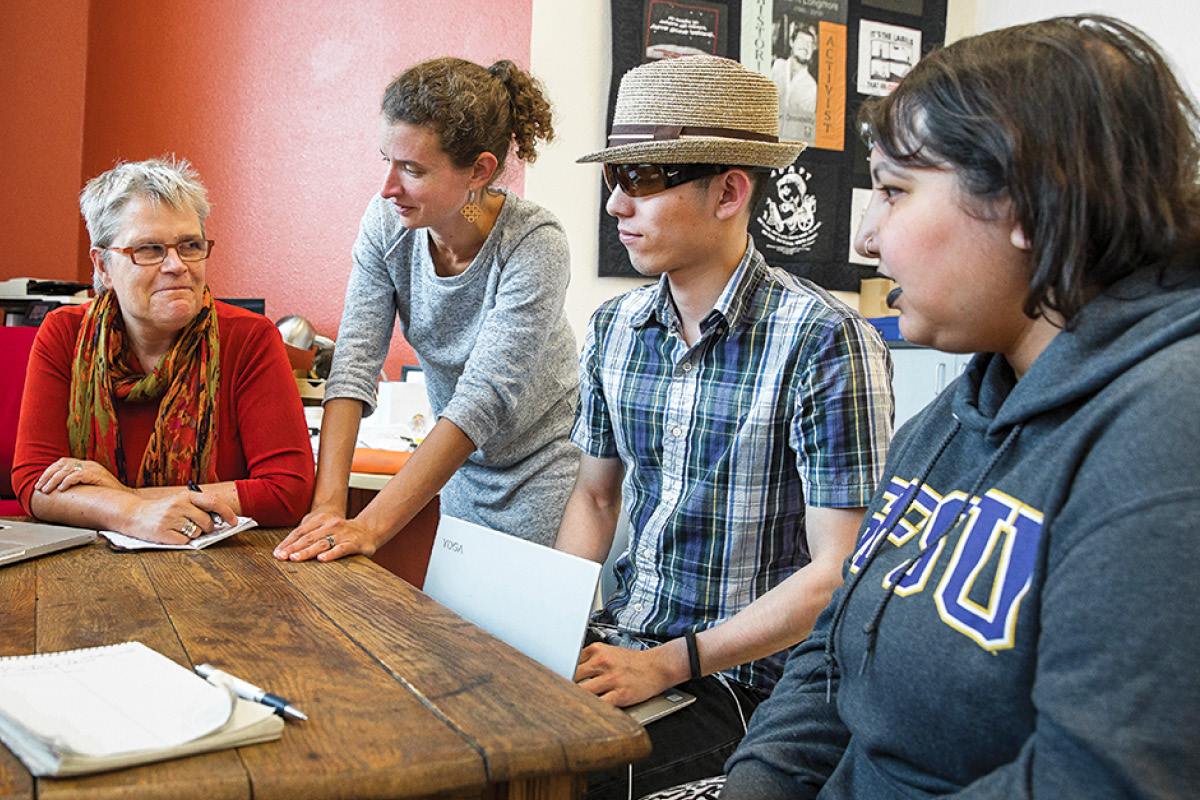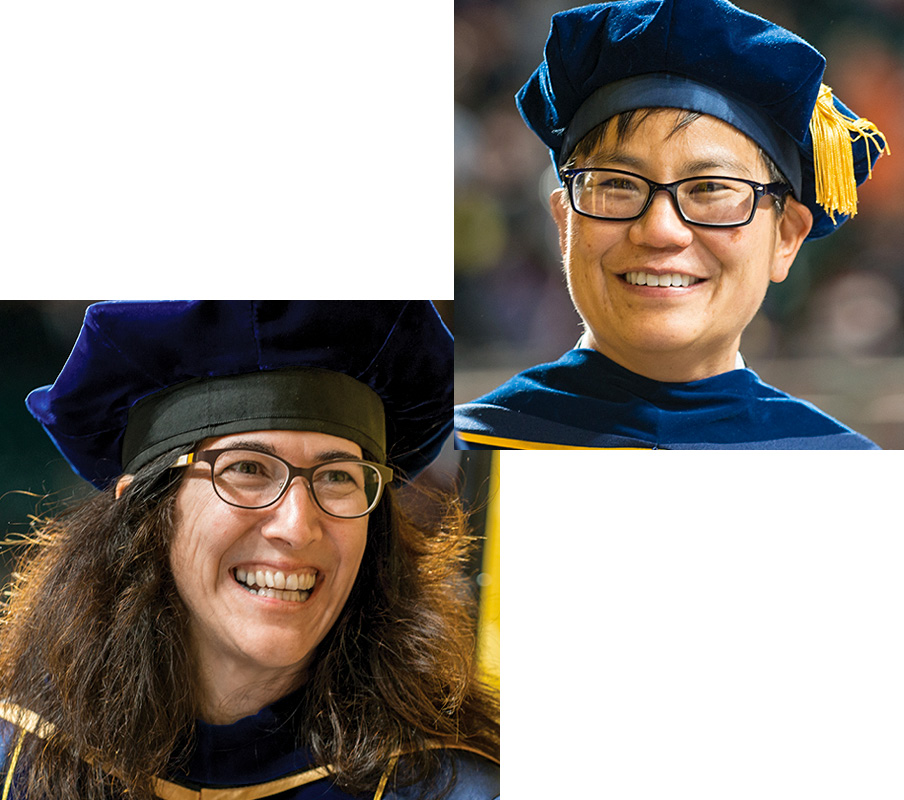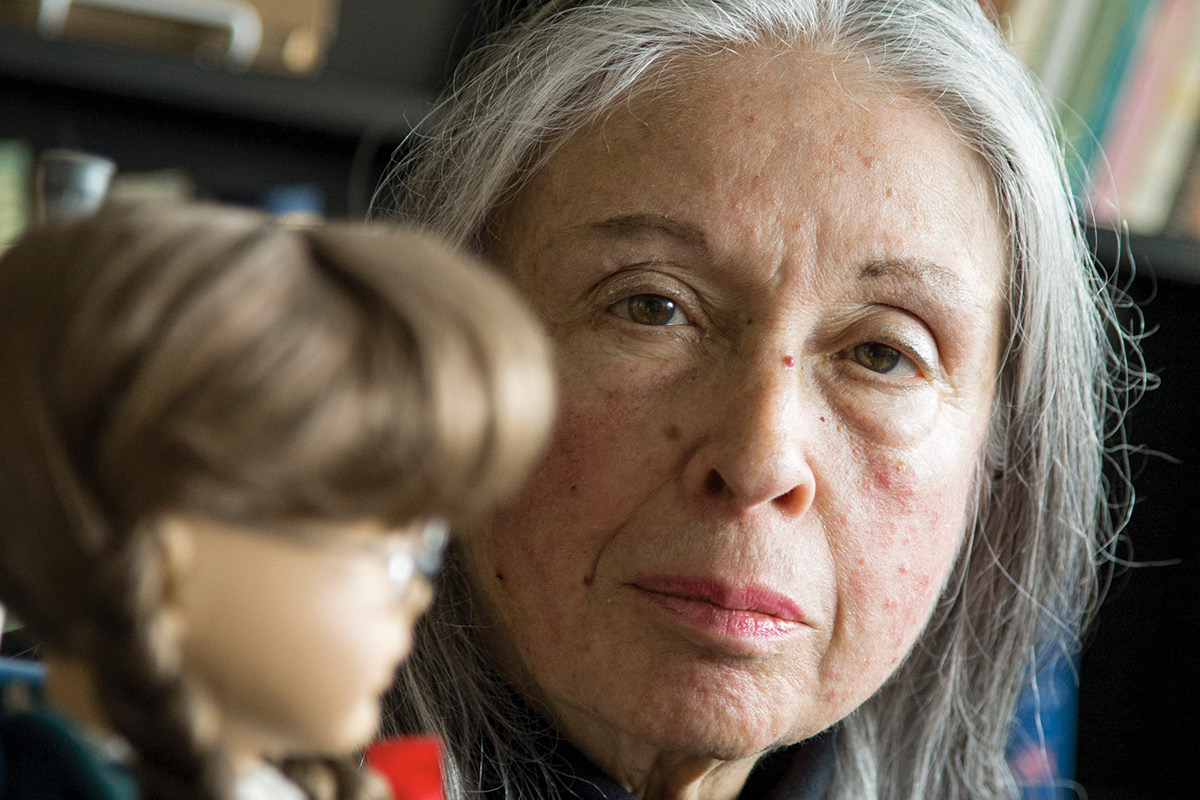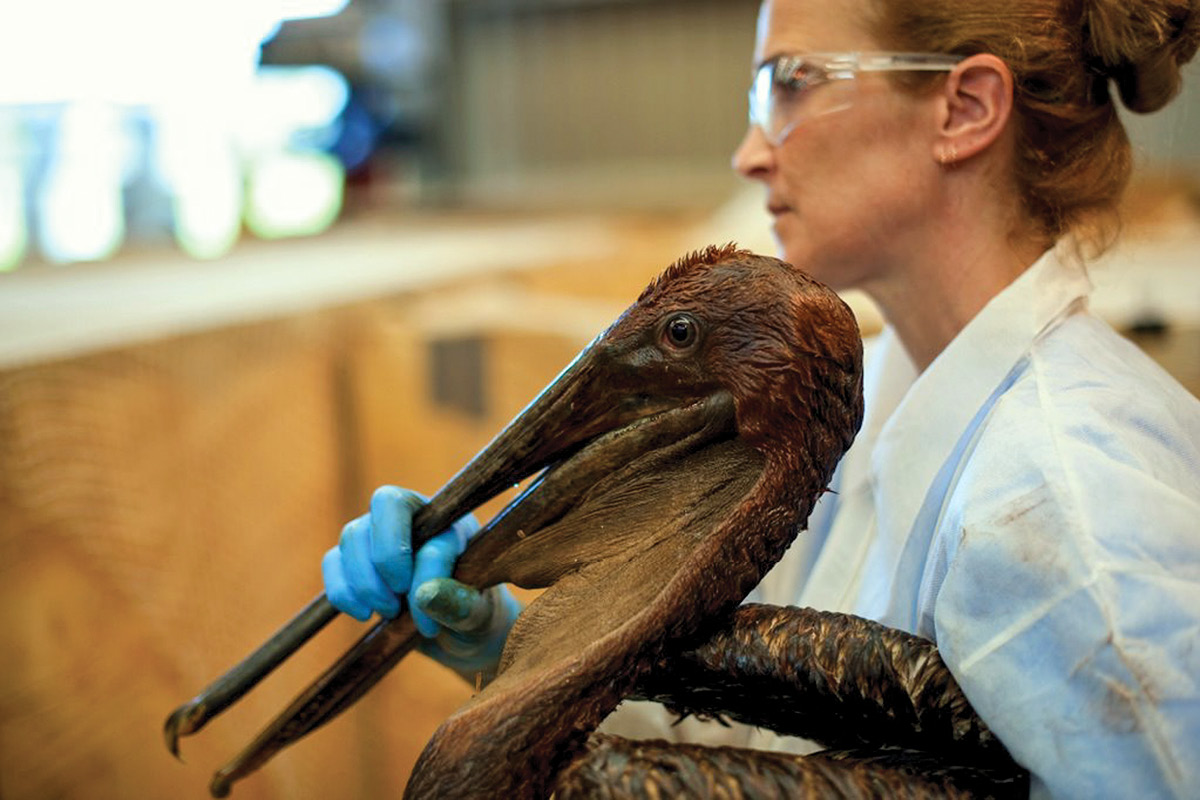
Acknowledging (for Real This Time) Female Scientists
From DNA pioneer Rosalind Franklin to the NASA mathematicians in the film Hidden Figures, the historical contributions of women to science are increasingly coming to light. And a new study by SF State researchers shows that it’s possible to reveal women’s once-hidden scientific work by analyzing decades-old research papers in the field of theoretical population biology. The historical bias shown by the research likely continues to impact the representation of women in the discipline today.
“What our work shows is that in fact there were women who were working in the field,” says Assistant Professor of Biology Rori Rohlfs. “But we didn’t even know they existed.”
“What our work shows us is that there were women who were working in the field.”
— Rori Rohlfs, Assistant Professor of Biology
To peek into the history of their discipline, Rohlfs and Brown University Assistant Professor of Ecology and Evolutionary Biology Emilia Huerta-Sánchez took advantage of how scientific research papers are structured. Being listed as an “author” of a scientific paper is the primary way scientists receive credit for their work and is critical to securing jobs and research funding. But those who contribute less to a paper are sometimes listed in the “acknowledgements” section, buried at the bottom and rarely read by other researchers.
When Rohlfs and Huerta-Sánchez noticed that many women seemed to appear only in the acknowledgements section of decades-old studies in their field — despite what appeared to be important programming contributions — the duo saw a chance to measure how much the work of women had been overlooked. Rohlfs recruited seven SF State undergraduate researchers to record data on the authors and acknowledgements from 883 papers published in the scientific journal Theoretical Population Biology between 1970 and 1990. They found that the people mentioned were disproportionately women: Women made up 43.2 percent of those mentioned as programmers in the acknowledgements but only 7.4 percent of those listed as authors.
Through the decades, the study shows, the proportion of women programmers in the acknowledgements shrank. That shift tracked broader trends in the workplace, as programming went from a “pink collar job” associated with women to one perceived as more masculine and prestigious.
Because these women never got proper credit for their work, they were denied the opportunity to advance as scientists, which may have had a lasting impact on the field. While women have increasingly found success in closely related fields like evolutionary biology, the more programming-heavy biology disciplines have lagged behind. “Population genetics continues to be male-dominated at the faculty level,” Rohlfs says. “In part that might be because women who were thinking about what subfield of biology they wanted to get into didn’t see women there.”
Through the decades, the study shows, the proportion of women programmers in the acknowledgements shrank. That shift tracked broader trends in the workplace, as programming went from a “pink collar job” associated with women to one perceived as more masculine and prestigious.

A Place of Their Own
San Francisco has a lot of unique cultural centers. There’s the Asian Pacific Islander Cultural Center, the United Irish Cultural Center, the Croatian American Cultural Center and many more. What San Francisco doesn’t have — because no city in the nation has one — is a disability cultural center.
That’s about to change thanks to SF State’s Paul K. Longmore Institute on Disability. Founded to showcase the experiences of people with disabilities, the Institute is spearheading development of the center after winning a $100,000 bid from the city’s Department of Aging and Adult Services (DAAS). The effort will be underwritten by the Dignity Fund, a voter-approved initiative that requires the city to apportion a part of its budget to DAAS for the benefit of older adults and adults with disabilities.
“San Francisco needs a place where people can engage with disability culture,” says San Francisco State Professor of History Catherine Kudlick, the Longmore Institute’s director. “No other city as far as we can tell has a disability cultural center, so this will be a trailblazer.”
Emily Beitiks, the Institute’s assistant director, and SF State senior Danny Thomas Vang, a fellow with the Institute, have assembled a leadership council of 12 people with disabilities. All are either disability advocates or work with people who have disabilities in San Francisco. “It’s important that the center is created by people with disabilities,” Kudlick says. “Traditionally, non-disabled people would be the ones making these decisions.”
The Write Stuff
Michael David Lukas has two well-reviewed novels under his belt, but that hasn’t taken any of the agonizing uncertainty out of writing.
“There are moments where you feel something click when you’re writing, but there’s always that self-doubt, that voice over my shoulder telling me that what I’m doing isn’t working,” he says.
Some recent news might help the Assistant Professor of Creative Writing finally set his self-doubt aside: In January his multigenerational novel The Last Watchman of Old Cairo won the 2018 National Jewish Book Award in fiction. Administered by the Jewish Book Council, the award recognizes outstanding literature that focuses on themes of Jewish interest.
Published by Spiegel & Grau last March, the novel is centered around Joseph, a literature student at Berkeley and the son of a Jewish mother and a Muslim father. The story follows Joseph’s attempts to unearth the two sides of his family lineage. Lukas, who has also lived and worked in Turkey and Tel Aviv, attributes much of his storytelling to his own personal travels. He’s currently working on a third novel that will be a futuristic retelling of the biblical book of Esther.
Though teaching takes time and energy away from his writing, Lukas says he finds his students’ thoughtful opinions and insightful questions inspiring.
“I’ve been really amazed by the students and I think if anything I feel like they’ve taught me so much,” says Lukas. “The recognition is really gratifying and great to have, but at the end of the day it’s about putting your butt in the chair and just writing.”


University Announces new deans
SF State appointed two new deans this spring: Amy Sueyoshi was named dean of the College of Ethnic Studies (CoES), while Carmen Domingo was named dean of the College of Science and Engineering (CoSE). Each is the first female dean for her college.
An accomplished scholar and dedicated educator, Sueyoshi (top photo) has been a faculty member at SF State in Race and Resistance Studies and in Sexuality Studies since 2002. She has published and taught in the areas of sexuality, gender and race and is also an LGBTQIA activist who was honored as the community grand marshal for the 47th Annual San Francisco Lesbian Gay Bisexual Transgender Pride Celebration and Parade in 2017.
Domingo has been a faculty member at SF State since 1997. A full-time professor in the Department of Biology, her research focuses on understanding the cellular and molecular mechanisms behind how embryos develop. Her career and research also focuses on efforts to increase the representation of women and underrepresented minorities in STEM fields.
In Memoriam: Anita Silvers
Nationally recognized advocate for disability rights and beloved Professor of Philosophy Anita Silvers passed away peacefully in her sleep Thursday, March 14. As a former chair of the Department of Philosophy, Silvers taught at SF State for more than 50 years, accruing professional accolades for her work and her service to students and colleagues. In 2017, she was awarded the California State University Wang Family Excellence Award in the Visual and Performing Arts and Letters category. She established a scholarship at SF State for philosophy students with the $20,000 award and supplemented the endowment with her own savings.
“Dr. Silvers embodied the highest scholarly achievements, mentoring commitment and service and leadership to San Francisco State and the greater community,” said Dean of the College of Liberal & Creative Arts Andrew Harris. “Philosophers know her as the philosophical voice of disability for almost single-handedly creating a new and fast-growing field of philosophical research.”
As a child, Silvers was disabled by quadriplegia from polio. Grounded in her own experiences, she became a leading advocate for equality for persons with disabilities. She produced groundbreaking research on disability and justice, including three co-authored books, six co-edited books and more than 125 articles, chapters and extensive reference entries. An SF State faculty member since 1967, Silvers worked to make California college campuses more accessible and to ensure that disability services were available.
“She has touched and transformed the lives of countless students, scholars and activists,” said Chair and Professor of Philosophy Justin Tiwald. “We must work to ensure that her memory and her inspiration outlives her, as she hoped and expected of us.”


Getting ready for the next big spill
SF State’s Estuary and Ocean Science (EOS) Center is now a partner organization with the Oiled Wildlife Care Network (OWCN), making the center a triage site for volunteers to care for wildlife affected by oil spills in San Francisco Bay.
“Now we’ll have a place to take the animals that’s right here in the Bay — because the EOS Center is the only place on the Bay that has that kind of space and capacity,” says San Francisco State Professor of Geography & Environment Ellen Hines, the Center’s associate director.
The OWCN has existed since 1994, created in part as a response to the Exxon Valdez spill in Alaska. Established by the California Department of Fish and Wildlife Office of Spill Prevention and Response and administered by the University of California, Davis Karen C. Drayer Wildlife Health Center, the OWCN organizes wildlife rescue and rehabilitation during California spills and provides funding for research and training for wildlife care volunteers. The network includes more than 40 member organizations throughout the state.
“Now we’ll have a place to take the animals that’s right here in the Bay.”
— Ellen Hines, Assistant Professor of Geography & Environment and EOS Associate Director
In the past, the organization was limited by a lack of space to organize volunteer efforts on the San Francisco Bay, which is vulnerable to oil spills due to heavy shipping traffic and the presence of several nearby refineries. For instance, after the Cosco Busan struck the Bay Bridge in 2007 and spilled more than 50,000 gallons of fuel, oil-covered animals had to be transported dozens of miles away to Cordelia to be cleaned. The 53-acre EOS Center campus and unique waterfront location will make it an ideal triage center for OWCN during any such accidents in the future. “Having the resources of the EOS Center available in the event of a major spill will provide an amazing benefit to responders,” says Marin County Sheriff’s Office Emergency Services Coordinator Tom Jordan.
Twenty students, faculty and staff at the EOS Center have already registered as volunteers. If a spill happens in the Bay, they and any new volunteers will be called up to the EOS Center to assist with the response effort.
“We are thrilled to have the EOS Center join the Oiled Wildlife Care Network,” says Scott Buhl, the OWCN’s wildlife response specialist. “They add fantastic personnel along with a critical site location that will further enhance our response capabilities.”